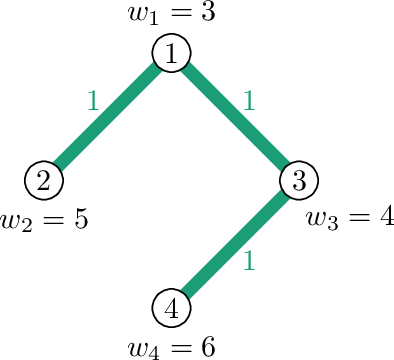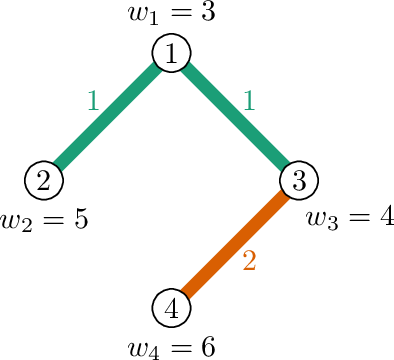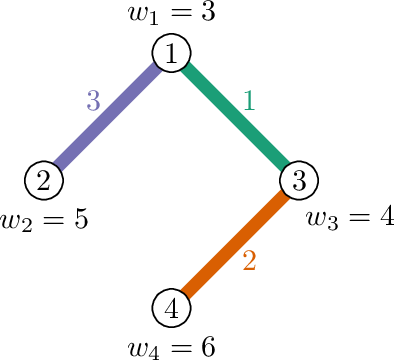CF1466D 13th Labour of Heracles
题目描述
你可能听说过赫拉克勒斯的十二项任务,但你知道第十三项吗?人们普遍认为他花了十二年完成这十二项壮举,平均每年完成一项。如今时光流转得更快,你只有几分钟而不是几个月来完成这个任务。你能做到吗?
本题中,给定一棵有 $n$ 个带权顶点的树。树是一个包含 $n-1$ 条边的连通图。
我们定义其 $k$ 染色为:将 $k$ 种颜色分配给树的边,使得每条边恰好被分配一种颜色。注意,你不必使用所有 $k$ 种颜色。
对于颜色 $x$ 的子图,包含原树中被分配为颜色 $x$ 的所有边,以及所有与这些边相连的顶点(即这些顶点的度数不为 $0$)。因此,子图中没有度数为 $0$ 的顶点。
一个连通分量的价值定义为其所有顶点权值之和。一个子图的价值定义为其所有连通分量价值的最大值。我们约定空子图的价值为 $0$。
$k$ 染色的价值定义为所有 $k$ 种颜色对应子图的价值之和。给定一棵树,对于每个 $k$ 从 $1$ 到 $n-1$,计算该树的最大 $k$ 染色价值。
输入格式
输入的第一行包含一个整数 $t$($1 \leq t \leq 10^5$),表示测试用例的数量。接下来是 $t$ 个测试用例。
每个测试用例的第一行包含一个整数 $n$($2 \leq n \leq 10^5$)。第二行包含 $n$ 个整数 $w_1, w_2, \dots, w_n$($0 \leq w_i \leq 10^9$),其中 $w_i$ 表示第 $i$ 个顶点的权值。接下来的 $n-1$ 行,每行包含两个整数 $u, v$($1 \leq u, v \leq n$),表示顶点 $u$ 和 $v$ 之间有一条边。保证这些边构成一棵树。
所有测试用例中 $n$ 的总和不超过 $2 \times 10^5$。
输出格式
对于每个测试用例,输出一行,包含 $n-1$ 个整数,用空格隔开。第 $i$ 个数表示该树的最大 $i$ 染色价值。
说明/提示
第一个测试用例的最优染色方案如下:

在 $1$ 染色中,所有边都被赋予相同的颜色。颜色 $1$ 的子图包含原图的所有边和顶点,因此其价值为 $3+5+4+6=18$。

在最优的 $2$ 染色中,边 $(2,1)$ 和 $(3,1)$ 被赋予颜色 $1$,边 $(4,3)$ 被赋予颜色 $2$。因此,颜色 $1$ 的子图是一个连通分量(顶点 $1,2,3$),其价值为 $3+5+4=12$。颜色 $2$ 的子图包含两个顶点和一条边,其价值为 $4+6=10$。

在最优的 $3$ 染色中,所有边都被赋予不同的颜色。因此,每种颜色的子图都只包含一条边。它们的价值分别为:$3+4=7$,$4+6=10$,$3+5=8$。
由 ChatGPT 4.1 翻译